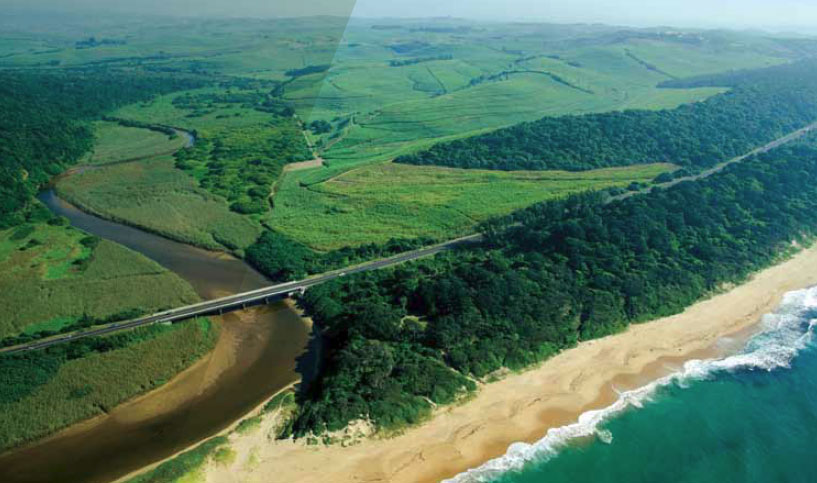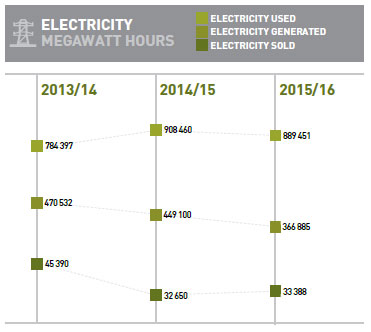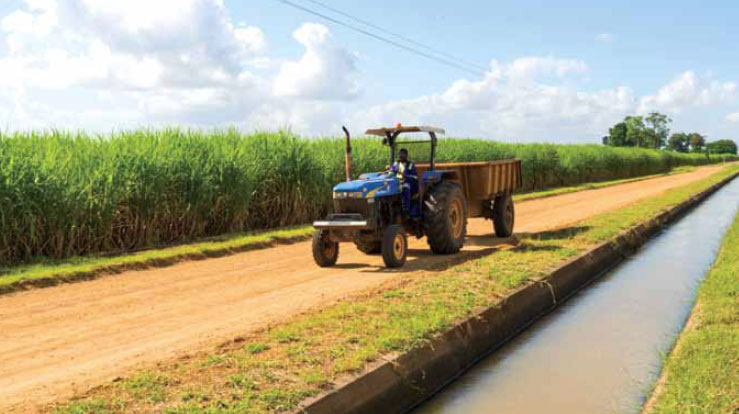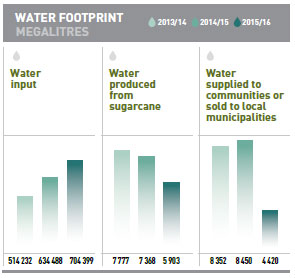Environment
Environmental Capital |
ENVIRONMENTAL STEWARDSHIP
Research subsequent to the Millennium Ecosystem Assessment (2001) indicates that natural resources, globally, remain under stress. Ecosystem degradation is a concern for most businesses given its indispensable role in global socio-economic systems. As a major user of land, biodiversity and water, Tongaat Hulett’s agri-processing and land development operations are significantly impacted by natural systems and in turn impact on the environment and local communities. As a responsible corporate citizen, Tongaat Hulett seeks to demonstrate its commitment to sound environmental stewardship, within a context of sustainable and ethical practice. Compliance with legal requirements is a minimum requirement, with operations striving to establish and accord with local and international best practices. In line with this approach, the company aims to retain and/or secure certification to ISO 14001 Environmental Management System standard across all its operations.
CLIMATE CHANGE
Agriculture is vulnerable to changes in climate and weather patterns. Tongaat Hulett recognises the need to adapt to the physical impacts of climate change, which will affect operations, particularly through the availability of water and the occurrence of extreme weather events. Tongaat Hulett operations are being impacted by current El Nińo conditions, with research suggesting a tentative but inconclusive link between the strength of El Nińo and climate change. Given the 40 percent decline in production in the South African sugar operation as a consequence of the El Nińo weather pattern, the company is engaging with experts on a number of innovative initiatives, including programmes to improve irrigation efficiency and more drought resistant crop varieties.
Tongaat Hulett’s approach to dealing with the impacts of climate change includes a drive towards greater energy-efficiency and the business is actively encouraging suppliers across the full value chain to do the same. The company participates in public environment forums and during the past year this included the 2015 United Nations Climate Change Conference (COP21), parliamentary discussions and the Davis Tax Committee on the proposed carbon tax in South Africa.
Carbon Management
As part of its broader response to climate change, Tongaat Hulett participated in the CDP (formerly Carbon Disclosure Project) for the seventh consecutive year. The CDP is an independent initiative that encourages transparency on climate change-related issues, with an emphasis on emissions disclosure. The company’s carbon footprint analysis was conducted according to the Greenhouse Gas (GHG) Protocol, a widely used international accounting tool. Details of the company’s actions underway are provided in the public response to the CDP, available at www.cdproject.net Tongaat Hulett tracks and monitors its GHG emissions, seeking through on-going efforts to improve the accuracy and reporting of its carbon footprint.
During the year, business operations emitted 811 994 metric tons CO2 equivalent (CO2-e) Scope 1 emissions (2014/15: 800 231). The company purchased electricity that emitted 305 794 metric tons of CO2-e (2014/15: 288 459). The total Scope 3 emissions were 32 496 metric tons CO2-e covering business travel, comprehensive supply chain transport and distribution by third-party companies (2014/15: 19 102). In the 2015/16 reporting period, employees booked nearly 6 310 business trips, flying more than 6,250 million kilometres, resulting in 1 217 metric tons CO2-e being emitted from business travel. The total Scope 1, Scope 2 and Scope 3 carbon emissions for the period under review was 1 150 284 metric tons CO2-e and the turnover was R16,676 billion, which equates to 69 grams of CO2 emitted per Rand generated. The GHG emissions have been verified by a third-party service provider.

Overall, there was a 1 percent increase in Scope 1 emissions from the previous period, 6 percent increase in purchased electricity due to more irrigation and 70 percent increase in Scope 3 owing to improved reporting in upstream and downstream distribution of products by third party service providers.
Total emissions from South African operations, calculated at 688 067 metric tons CO2-e, includes emissions of 359 696 metric tons CO2-e emanating from the South African sugar operations. Tongaat Hulett recently completed a study with the assistance of carbon specialists which found that the company’s sugar farms sequester carbon at a rate of 12 tons per hectare per annum from sugarcane produced. Using this rate, Tongaat Hulett’s 39 116 hectares (grown from company-owned and leased land) equates to 469 392 metric tons sequestered CO2-e per annum. The South African sugar operations could benefit from the carbon capture and storage of CO2 in the growing of sugarcane if the National Treasury allows for sequestered emissions to be deducted from the company’s carbon footprint. Therefore 218 675 metric tons would have been subject to carbon tax in this financial year had it been instituted.

Energy

The introduction of a suitable regulatory framework for the provision of privately-produced alternative electricity to the national grid in South Africa could potentially result in Tongaat Hulett expanding the business’s ability to generate electricity from bagasse, a renewable resource produced as a co-product of the sugar production process. In the short to medium term, this would involve infrastructure development projects across the company’s sugar mills to significantly increase electricity generation from bagasse. For the year ended 31 March 2016, Tongaat Hulett used a total of 889 451 MWh (2014/15: 908 460 MWh) of electricity across all of its operations and offices. It generated 366 885 MWh (2014/15: 449 100 MWh) from its sugar mills, predominantly from bagasse, and sold 33 388 MWh (2014/15: 32 650 MWh) to the national grid. Other sources of fuel that are used include coal 282 885 tons (2014/15: 280 646 tons), diesel 12,7 million litres (2014/15: 12,7 million litres), petrol 0,994 million litres (2014/15: 1,04 million litres), gas 492 397 GJ (2014/15: 427 910 GJ) and wood.
Air Quality
The deliberate strategy of burning bagasse ahead of coal as a fuel by sugar mills significantly improves the quality of emissions in terms of particulate matter, noxious gases, carbon and sulphur oxide. Wet scrubbing technology continues to be used by most operations to remove fly-ash from the flue gas to ensure that emissions meet acceptable air quality standards. Tightening regulatory constraints and changing societal expectations in relation to air emissions present challenges and opportunities for the business. While some emissions will always be inevitable because of the very nature of manufacturing operations, the company realises the need to improve performance. In 2015, it implemented a significantly revised air quality protection standard which sets high performance expectations on operations in line with respective country-specific legal regimes.
The primary use of coal as a fuel to fire boilers at the refinery in South Africa presents challenges in improving the quality of emissions. To address this, the company has developed an improved process technology solution which could be applied at that operation.
Biodiversity and Land Management
A total of 7 970 developable hectares of land in KwaZulu-Natal has been identified for conversion, at the appropriate time, in support of growth and development of the region. This conversion is carefully managed and coordinated in line with broader government objectives and spatial policies. A major element of this conversion includes the rehabilitation of the affected ecological systems through a range of biodiversity improvement practices.
Soil health plays a critical role in maintaining biodiversity. Experts warn that 33 percent of world soil is already moderately to highly degraded due to erosion, nutrient depletion, acidification, urbanisation, and chemical pollution, putting future supplies of food, water and energy at risk. Tongaat Hulett continues to rehabilitate currently unproductive land to agriculture, while also securing additional sugarcane supply to its mills.
Water Resource Management
Water resources management takes place in the context of the water-energy-food nexus and is informed by the CDP Water Disclosure, the 2030 Water Resources Group (2030 WRG), the National Water Resources Strategy released by the South African Department of Water Affairs and the Alliance for Water Stewardship. Tongaat Hulett is involved in water partnership projects addressing locally-relevant issues such as watershed protection, access to safe drinking water, sanitation, agricultural water efficiency, and education and awareness.
The CDP’s water programme provides a framework that enables companies and investors to take meaningful action to improve water security worldwide. Investors collectively managing more than US$63 trillion and multinational companies with a combined procurement spend of US$214 billion requested companies to respond through CDP’s water programme in 2015.
As an agriculture and agri-processing business, water is a vital part of Tongaat Hulett’s daily operations. Climate change, with its consequent impacts on water availability and water quality, continues to impact a number of the regions in which Tongaat Hulett and its suppliers operate. Water pollution has the potential to increase operational costs and compromise the quality of produced products. It is therefore in Tongaat Hulett’s interest to ensure sustainable management of shared water resources in the regions where it operates and procures from.

“For these reasons, the CDP acknowledged Tongaat Hulett’s continued commitment to transparent corporate water stewardship. The business has been responding to its stakeholders’ requests for information via CDP since 2011, and this year its water response was assessed against the CDP’s water scoring methodology. The result indicates that Tongaat Hulett:
- Measures impacts and is taking steps to reduce them.
- Identifies water risks at the river basin level and reported response strategies to tackle them.
- Monitors total water withdrawals by source, consumption and discharges by destination.
- Has implemented a water policy and a strategic framework that outlines clear action.
The business is committed to improving its water management practices to maintain consistent and high-quality production in the future. While improving water security globally is an ambitious undertaking, the actions that companies such as Tongaat Hulett are taking demonstrate an understanding of the scale and nature of the challenge as well as the importance of addressing it. We congratulate Tongaat Hulett on their actions thus far and encourage the company to continue to improve its corporate water stewardship.”
Cate Lamb - Head of CDP's Water Programme

Input water sources include water abstracted from rivers, water available in sugarcane and water purchased from municipal sources. Most sugar mills operate in remote locations and therefore assist in the provision of potable water to local communities. For the reporting year ended 31 March 2016, the total water input was 704 399 mega litres (2014/15: 634 488) of which 5 903 mega litres (2014/15: 7 368) was produced from sugarcane and 4 420 mega litres (2014/15: 8 450) was supplied to communities or sold to local municipalities. Overall, there was a 20 percent decrease in water produced from sugarcane as the business crushed less cane due to drought.
Effluent Management
The company remains committed to achieving ‘zero effluent` disposal. Current efforts are aimed at reducing effluent discharged from production processes and ensuring containment of excess effluent that would be subjected to a dilution process prior to being re-used in irrigating nearby crops where practical. Most of Tongaat Hulett’s sugar mills recycle and re-use water within the factories, while the remaining effluent undergoes biological treatment (aerobic and anaerobic) to reduce its chemical oxygen demand to acceptable levels before being discharged in accordance with the relevant environmental requirements.
The remaining mills are progressing with environmental management programmes to adopt best practices and ensure legal compliance as a minimum. Water that is produced as part of the sugar milling process is largely used for the irrigation of sugarcane on adjacent estates and effluent produced at the central sugar refinery is disposed of into the municipal sewer for treatment. The quantity and quality thereof is monitored to ensure compliance with the relevant specifications.
Waste Management
Tongaat Hulett continues to effectively and efficiently manage waste to protect human health and the environment, minimise disposal costs, and avoid creating future liabilities. It is working towards reducing the amount of hazardous waste produced from production processes with the ultimate objective of achieving ‘zero hazardous waste’. Various options are being explored to reduce, re-use and recycle waste before its ultimate disposal. Operations based in South Africa, Mozambique, Botswana, Namibia and Swaziland make use of registered waste companies that collect non-valuable hazardous waste from operations and dispose of it at designated hazardous landfill sites. The Zimbabwean operations have constructed hazardous disposal sites that are registered by the regulatory authority and are subject to annual statutory and third-party audits.
During the reporting period 2015/16, 10 387 tons of general waste (2014/15: 12 096 tons), 2 486 tons of scrap metal (2014/15: 2 455 tons) and 763 tons of hazardous waste (2014/15: 4 822 tons) was generated and disposed of in accordance with applicable legislation.
Environmental incidents and Compliance
The company responded to most concerns raised by affected stakeholders, mainly from surrounding communities. There were no serious incidents or non-monetary sanctions for non-compliance with applicable environmental regulations registered during the year under review. The established community liaison forums between Tongaat Hulett and interested parties continue to address environmentally-related complaints.
A total of two Level 2 incidents (2014/15: 1) and 416 Level 1 (2014/15: 581) incidents were recorded while 92 complaints (Level 1: 92 and Level 2: 0) were registered and attended to. Most of the Level 1 complaints were recorded at starch operations being related to odour emanating from production processes. Appropriate corrective action and engagement processes with affected parties were undertaken. The Level 2 incidents were reported at Triangle operations in Zimbabwe and Agricultural operations in South Africa. Most Level 1 incidents were related to vandal fires as well as illegal dumping incidents perpetrated by unidentified members of the public.
Independent Third-party Assurance
Environmental Resources Management (ERM) has provided independent third-party assurance over selected sustainability content of the Integrated Annual Report 2016. The assurance was conducted in line with the AccountAbility AA1000 Assurance Standard (Revised, 2008) (Type I Moderate level). The engagement was conducted using the AA1000 AccountAbility Principles Standard (2008) criteria and those of the GRI G3.1 Sustainability Reporting Guidelines. For the detailed assurance statement refer to
Read more


